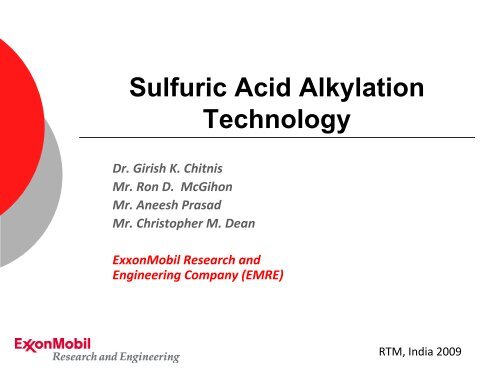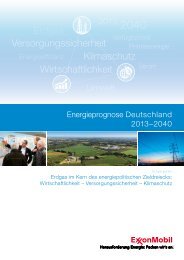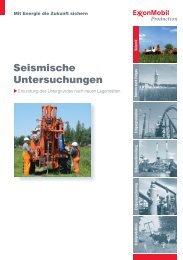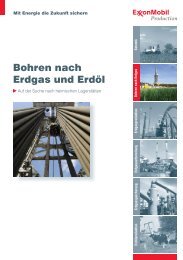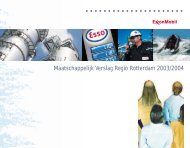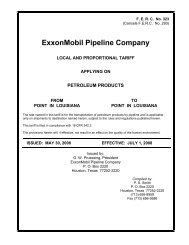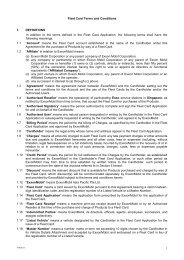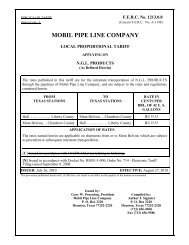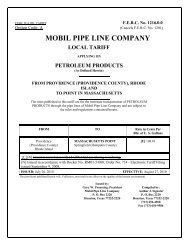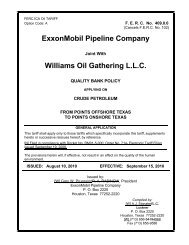Sulfuric Acid Alkylation Technology - ExxonMobil
Sulfuric Acid Alkylation Technology - ExxonMobil
Sulfuric Acid Alkylation Technology - ExxonMobil
Create successful ePaper yourself
Turn your PDF publications into a flip-book with our unique Google optimized e-Paper software.
<strong>Sulfuric</strong> <strong>Acid</strong> <strong>Alkylation</strong><br />
Dr. Girish K. Chitnis<br />
Mr. Ron D. McGihon<br />
Mr. Aneesh Prasad<br />
Mr. Christopher M. Dean<br />
<strong>Technology</strong><br />
<strong>ExxonMobil</strong> Research and<br />
Engineering Company (EMRE)<br />
RTM, India 2009
Overview<br />
Growing Importance of <strong>Alkylation</strong><br />
Basic Chemistry and Process Flow<br />
Critical <strong>Alkylation</strong> Unit Design Considerations<br />
Reactor/Settler Design<br />
Reactor Cooling Efficiency<br />
Reactor Product Treating<br />
Isobutane Availability<br />
Design and Operating Experience<br />
Summary<br />
2
Installed Capacity - “History of <strong>Alkylation</strong>”<br />
bpd<br />
1,800,000<br />
1,600,000<br />
1,400,000<br />
1,200,000<br />
1,000,000<br />
800,000<br />
600,000<br />
400,000<br />
200,000<br />
0<br />
1940 1950 1960 1970 1980 1990 2000<br />
A radical change from 1990 on… on<br />
<strong>Sulfuric</strong> <strong>Acid</strong> <strong>Alkylation</strong> the current technology of choice<br />
Total<br />
<strong>Sulfuric</strong><br />
HF<br />
3
Comparing cost of technologies in<br />
equal basis...<br />
4
Growing Importance of <strong>Alkylation</strong><br />
Increased Incentive with Expanded Refining and<br />
Cracking Capacity and Entry into Global Market<br />
place<br />
FCC and Coker Expansions<br />
Export Refineries<br />
Reduced Emissions Gasoline Regulations Favor<br />
Alkylate Blendstock<br />
Alkylate Blendstock<br />
No Olefins<br />
No Aromatics<br />
Low Sulfur<br />
Low RVP<br />
High Octane<br />
Good Distillation Characteristics<br />
5
<strong>Alkylation</strong> Chemistry – Simplified<br />
Primary <strong>Alkylation</strong> Reactions<br />
C3= + iC4<br />
C4= + iC4<br />
C5= + iC4<br />
iC7<br />
iC8<br />
iC9<br />
RON MON RVP<br />
88<br />
96<br />
88<br />
87<br />
94<br />
87<br />
, psi<br />
RVP, psi<br />
Secondary Reactions Produce Wide Spectrum of Compounds<br />
Polymerization<br />
Hydrogen Transfer<br />
Disproportionation<br />
Cracking<br />
Esters Produced as Reaction Intermediates May be Present<br />
Feed Impurities Form <strong>Acid</strong> Soluble Compounds<br />
3.8<br />
2.6<br />
4.0<br />
6
Simplified Flow Diagram<br />
<strong>ExxonMobil</strong> Stirred, Autorefrigerated <strong>Alkylation</strong> Process<br />
Compression System<br />
Olefin Feed<br />
Isobutane<br />
CW<br />
Refrigeration<br />
<strong>Acid</strong><br />
Caustic Water<br />
Effluent Wash X 2<br />
Reactor System<br />
Recycle Isobutane<br />
Fractionation System<br />
CW<br />
STM<br />
CW<br />
STM<br />
CW<br />
Propane<br />
Butane<br />
Alkylate<br />
7
Overview of <strong>Alkylation</strong> Process<br />
Variables<br />
Variable Typical Range Effect On Process<br />
Isobutane Concentration<br />
(Average)<br />
50 - 70 LV%<br />
Olefin Space Velocity 0.1 - 0.3 V/H/V<br />
Temperature (Average) 40 - 50°F<br />
Percent <strong>Acid</strong>-In-Emulsion 50 - 60 LV%<br />
Spent <strong>Acid</strong> Strength<br />
(SAS)<br />
90 - 92 WT% H2SO4<br />
Mixing Moderate - Intense<br />
Olefin Injection<br />
• High Isobutane Concentration Preferred<br />
• Low Space Velocity Desired<br />
• Lower Temperature Desired<br />
• Maintain Greater Than 50%<br />
• This Range Considered Near Optimum<br />
• Good Mixing Essential<br />
• Feed Point Conditions are Important<br />
<strong>ExxonMobil</strong> Selects Design Conditions for Economic Balance of<br />
Process Performance Versus Capital and Operating Costs<br />
8
Olefin Feed<br />
Plus<br />
Isobutane<br />
Recycle<br />
Refrigerant<br />
Distinguishing Process Features<br />
Reactor Capacity<br />
<strong>ExxonMobil</strong> Autorefrigeration<br />
System<br />
Hydrocarbon Vapors<br />
to Refrigeration Compressor<br />
M M M M M<br />
Recycle <strong>Acid</strong><br />
Reactor<br />
Single Reactor<br />
Up to 9000 BPSD Alkylate Each<br />
Low Space Velocity<br />
Negligible Ester Formation<br />
Simple Rx. Product Treating<br />
No DIB Overhead Corrosion or DIB<br />
Reboiler Fouling<br />
To<br />
Deisobutanizer<br />
Hydrocarbon<br />
<strong>Acid</strong><br />
Settler<br />
Olefin Feed<br />
Plus<br />
Isobutane<br />
Recycle<br />
Settler Hydrocarbon Vapors<br />
to Refrigeration<br />
Hydrocarbon<br />
Compressor<br />
<strong>Acid</strong><br />
KO Drum<br />
M M<br />
Indirect Refrigeration<br />
System<br />
Refrigerant<br />
To<br />
Deisobutanizer<br />
Multiple Reactors<br />
Up to 2000 BPSD Alkylate Each<br />
High Space Velocity<br />
Significant Ester Formation<br />
Requires Expensive <strong>Acid</strong> Wash<br />
<strong>Acid</strong> Wash Claimed Effective for DIB<br />
Corrosion/Fouling Mitigation<br />
9
Olefin Feed<br />
Plus<br />
Isobutane<br />
Recycle<br />
Refrigerant<br />
Direct iC4 Vaporization<br />
Zero Degree Temperature<br />
Approach<br />
Simple Internals<br />
Low Pressure Reactor<br />
Low Mixing Power<br />
Sufficient for Emulsification<br />
Distinguishing Process Features<br />
Reactor Cooling Methods<br />
<strong>ExxonMobil</strong> Autorefrigeration<br />
System<br />
Hydrocarbon Vapors<br />
to Refrigeration Compressor<br />
M M M M M<br />
Recycle <strong>Acid</strong><br />
Reactor<br />
To<br />
Deisobutanizer<br />
Hydrocarbon<br />
<strong>Acid</strong><br />
Settler<br />
Settler<br />
Reactor<br />
M<br />
Olefin Feed<br />
Plus<br />
Isobutane<br />
Recycle<br />
Hydrocarbon<br />
<strong>Acid</strong><br />
Recycle <strong>Acid</strong><br />
Refrigerant<br />
Indirect Refrigeration<br />
System<br />
KO Drum<br />
Hydrocarbon Vapors<br />
to Refrigeration<br />
Compressor<br />
To<br />
Deisobutanizer<br />
No iC4 Vaporization<br />
Finite Delta Temperature Required<br />
Large No. of Tubes for Indirect Cooling<br />
Higher Pressure Reactor<br />
Higher Mixing Power<br />
Needed for Circulation and Heat Transfer<br />
<strong>ExxonMobil</strong> Reactor is Simpler and More Energy Efficient<br />
10
Reactor<br />
Product<br />
85 o F<br />
10 wt %<br />
NaOH<br />
Distinguishing Process Features<br />
Reactor Product Treating<br />
<strong>ExxonMobil</strong> System Alternative System<br />
Caustic<br />
Wash<br />
Water<br />
Wash<br />
To DIB<br />
Fresh Water<br />
Reactor<br />
Product<br />
<strong>ExxonMobil</strong> Treating System Less Complex<br />
Simple Settling Drums and Smaller Vessel Sizes<br />
Fresh <strong>Acid</strong><br />
<strong>Acid</strong> Wash<br />
(Electrostatic<br />
Precipitator)<br />
Alkaline<br />
Water Wash<br />
No Stream Heating Required, Results in Lower Cooling Water and Smaller DIB Condenser<br />
<strong>ExxonMobil</strong> Treating System Provides Low Risk of Serious Consequence<br />
Consequence<br />
in Event of <strong>Acid</strong> Carryover Upset<br />
<strong>ExxonMobil</strong> Treating System is Simpler and Lower Cost<br />
Fresh Water<br />
plus<br />
2 wt % NaOH<br />
To DIB<br />
11<br />
120 o F
<strong>Alkylation</strong> Plant<br />
Relative Investment Comparison<br />
Equipment Section<br />
Relative Investment<br />
<strong>ExxonMobil</strong><br />
Autorefrigeration<br />
Indirect<br />
Refrigeration<br />
Reactor/Settler Base Higher<br />
Reactor Product Treating Base Higher<br />
Refrigeration Base Higher<br />
Deisobutanizer and Debutanizer Base Base<br />
Depropanizer Feed Treating Base Base<br />
Depropanizer Base Base<br />
<strong>ExxonMobil</strong> Auto‐refrigeration Auto refrigeration Process Features Reduce Investment<br />
Fewer Reactor and Settler Vessels<br />
Less Complex Reactor Product Treating Facilities<br />
Smaller Refrigeration Compressor<br />
<strong>ExxonMobil</strong> Autorefrigeration Process Has Lower Plant Investment<br />
12
<strong>Alkylation</strong> Commercial Experience List<br />
Company Location<br />
Nominal Alkylate<br />
KBSD<br />
Start‐Up Year<br />
<strong>ExxonMobil</strong> Unit U.S. 30 1956<br />
<strong>ExxonMobil</strong> Unit U.S. 30 1957<br />
Licensed Unit U.S. 10 1958<br />
<strong>ExxonMobil</strong> Unit Japan 2 1958<br />
<strong>ExxonMobil</strong> Unit Aruba 4 1958<br />
Licensed Unit Japan 4 1986<br />
<strong>ExxonMobil</strong> Unit Japan 8 1988<br />
<strong>ExxonMobil</strong> Unit Belgium 6 1991<br />
<strong>ExxonMobil</strong> Unit France 6 1993<br />
Licensed Unit U.S. 7 1994<br />
Licensed Unit Thailand 7 Deferred<br />
Licensed Unit Taiwan 14 2000<br />
<strong>ExxonMobil</strong> Unit Australia 2 2001<br />
Licensed Unit Russia 9 2005<br />
Licensed Unit India 83 KBSD 2009<br />
Licensed Unit India 15 KBSD 2012<br />
13
Independent Evaluation <strong>Sulfuric</strong> <strong>Acid</strong><br />
<strong>Alkylation</strong> Plant Economics*<br />
Capital Investment (ISBL), M$<br />
Utilities, M$/Yr**<br />
<strong>ExxonMobil</strong><br />
Autorefrigeration<br />
<strong>ExxonMobil</strong> Plant Investment 7% Lower Than Indirect Refrigeration<br />
<strong>ExxonMobil</strong> Plant Utility Costs 21% Lower Than Indirect<br />
Refrigeration<br />
Indirect<br />
Refrigeration<br />
43.5 47.0<br />
7.1 9.0<br />
References:<br />
Catalyst Consultants, Inc., “Refinery <strong>Alkylation</strong>: An Environmental, Technical, and Process Assessment”, April,<br />
1991, pages 3.42 and 3.46.<br />
*Basis is 10 kBCD alkylate, 1991 basis updated to 2000 U.S. Gulf Coast location, inside battery limits<br />
**Utilities include power, cooling water, and steam<br />
14
Isobutane<br />
Olefin<br />
Feed<br />
Designing for Isobutane Availability<br />
Option 1‐Bypass Olefins<br />
Minimum Investment<br />
Reduced Alkylate Make <strong>Alkylation</strong><br />
Olefin Feed<br />
Unit<br />
Splitter<br />
<strong>Alkylation</strong><br />
Unit<br />
Isobutane<br />
Propane<br />
Alkylate<br />
n-Butane<br />
Olefin Sales<br />
Propane<br />
Alkylate<br />
n-Butane<br />
Olefin Sales<br />
Option 2‐Olefin Splitter<br />
Alkylate Above Option 1<br />
Increased Energy Costs<br />
Isobutylene a Higher<br />
Percentage of <strong>Alkylation</strong> Unit<br />
Feed<br />
15
Designing for Isobutane Availability<br />
Option 3‐EMOGAS Unit<br />
Lower Investment and Operating<br />
Costs<br />
Dimerize Olefins to Balance<br />
Isobutane<br />
Operate EMOGAS Reactors to<br />
Control Conversion<br />
Gasoline Production Above Option 2<br />
Olefin<br />
Feed<br />
Isobutane<br />
<strong>Alkylation</strong><br />
Unit<br />
n-Butane<br />
Isomerization<br />
Isobutane<br />
Olefin Feed<br />
Propane<br />
Alkylate<br />
n-Butane<br />
Unreacted<br />
Olefins<br />
EMOGAS<br />
<strong>Alkylation</strong><br />
Unit<br />
Propane<br />
Alkylate<br />
n-Butane<br />
Poly<br />
Gasoline<br />
Olefin Sales<br />
Option 4‐ Butane Isomerization<br />
Maximizes Alkylate Production<br />
Highest Investment Cost<br />
16
Summary<br />
<strong>ExxonMobil</strong>’s <strong>ExxonMobil</strong> s Process is a Significant Improvement Over the Indirect<br />
Refrigeration Design<br />
<strong>ExxonMobil</strong>’s <strong>ExxonMobil</strong> s Process Consumes Less Utilities (10‐20% (10 20% less)<br />
Lower Power Use in Auto‐refrigerated System is Significant<br />
<strong>ExxonMobil</strong>’s <strong>ExxonMobil</strong> s Process Leads to Lower Plant Investment (7% lower)<br />
Smaller Refrigeration Compressor<br />
Single Train Reactor<br />
Simple Reactor Design ‐ Amenable to Competitive Bidding Based<br />
on <strong>ExxonMobil</strong> Specifications<br />
Less Costly Treating Facilities<br />
<strong>ExxonMobil</strong>’s <strong>ExxonMobil</strong> s Process Has High Reliability<br />
Mixer seals in vapor space; replaceable during operation<br />
<strong>ExxonMobil</strong> has recently licensed 2 <strong>Alkylation</strong> units in India.<br />
The first 83 kbsd unit has started –up and is operating well.<br />
17
Thank You!<br />
18


